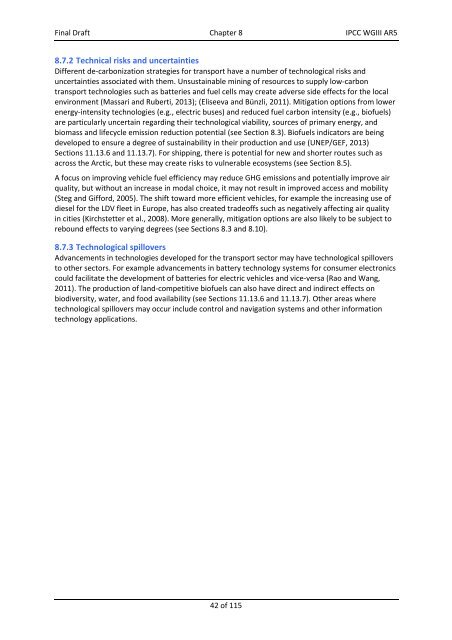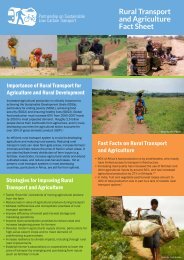Final Draft Chapter 8 IPCC WGIII AR5 8.7.2 Technical risks and uncertainties Different de‐carbonization strategies for transport have a number of technological risks and uncertainties associated with them. Unsustainable mining of resources to supply low‐carbon transport technologies such as batteries and fuel cells may create adverse side effects for the local environment (Massari and Ruberti, 2013); (Eliseeva and Bünzli, 2011). Mitigation options from lower energy‐intensity technologies (e.g., electric buses) and reduced fuel carbon intensity (e.g., biofuels) are particularly uncertain regarding their technological viability, sources of primary energy, and biomass and lifecycle emission reduction potential (see Section 8.3). Biofuels indicators are being developed to ensure a degree of sustainability in their production and use (UNEP/GEF, 2013) Sections 11.13.6 and 11.13.7). For shipping, there is potential for new and shorter routes such as across the Arctic, but these may create risks to vulnerable ecosystems (see Section 8.5). A focus on improving vehicle fuel efficiency may reduce GHG emissions and potentially improve air quality, but without an increase in modal choice, it may not result in improved access and mobility (Steg and Gifford, 2005). The shift toward more efficient vehicles, for example the increasing use of diesel for the LDV fleet in Europe, has also created tradeoffs such as negatively affecting air quality in cities (Kirchstetter et al., 2008). More generally, mitigation options are also likely to be subject to rebound effects to varying degrees (see Sections 8.3 and 8.10). 8.7.3 Technological spillovers Advancements in technologies developed for the transport sector may have technological spillovers to other sectors. For example advancements in battery technology systems for consumer electronics could facilitate the development of batteries for electric vehicles and vice‐versa (Rao and Wang, 2011). The production of land‐competitive biofuels can also have direct and indirect effects on biodiversity, water, and food availability (see Sections 11.13.6 and 11.13.7). Other areas where technological spillovers may occur include control and navigation systems and other information technology applications. 42 of 115
Final Draft Chapter 8 IPCC WGIII AR5 Table 8.4: Overview of potential co-benefits (green arrows) and adverse side effects (orange arrows) of the main mitigation measures in the transport sector. Arrows pointing up/down denote positive/negative effect on the respective objective/concern; a question mark (?) denotes an uncertain net effect. Co-benefits and adverse side-effects depend on local circumstances as well as on the implementation practice, pace, and scale (see Section 6.6). For an assessment of macroeconomic, cross-sectoral effects associated with mitigation policies (e.g., energy prices, consumption, growth, and trade), see Sections 3.9, 6.3.6, 13.2.2.3 and 14.4.2. For possible upstream effects of low-carbon electricity and biomass supply, see Sections 7.9 as well as 11.7 and 11.13.6. Mitigation Effect on additional objectives/concerns measures Economic Social (including health) Environmental Reduction of fuel carbon intensity: electricity, hydrogen, CNG, biofuels, and other fuels. ↑ ↑ Energy security (diversification, reduced oil dependence, and exposure to oil price volatility) (1,2,3,32,33,34,94) Technological spillovers (e.g., battery technologies for consumer electronics) (17,18,44,55,90) ? ↓ ↑ ↓ ↓ Health impact via urban air pollution (59,69) by CNG, biofuels: net effect unclear (13,14,19,20,36,50) Electricity, hydrogen: reducing most pollutants (13,20,21,36,58,63,92) Shift to diesel: potentially increasing pollution (11,23,25) Noise (electricity and fuel cell LDVs) (10,82,61,64–66) Road safety (silent electric LDVs at low speed) (56) ↓ ↑ ? Ecosystem impact of electricity and hydrogen via: Urban air pollution (13,20,69,91,92,93) Material use (unsustainable resource mining) (17,18) Ecosystem impact of biofuels (24,41,42,89) Reduction of energy intensity. ↑ Energy security (reduced oil dependence and exposure to oil price volatility) (1,2,3,32,33,34) ↓ ↑ Health impact via reduced urban air pollution (22,25,43,59,62,69,84) Road safety (crash‐worthiness depending on the design of the standards) (38,39,52,60) ↓ Ecosystem and biodiversity impact via reduced urban air pollution (20,22,69,95) Compact urban form and improved transport infrastructure. Modal shift. ↑ ↑ ? Energy security (reduced oil dependence and exposure to oil price volatility) (77–80,86) Productivity (reduced urban congestion and travel times, affordable and accessible transport) (6,7,8,26,35,45,46,48,49) Employment opportunities in the public transport sector vs. car manufacturing jobs (38,76,89) ↓ ↑ ↓ ↑ ↑ Health impact for non‐motorized modes via Increased activity (7,12,27,28,29,51,64,70,73,74) Potentially higher exposure to air pollution (19,27,59,69,70,74) Noise (modal shift and travel reduction) (58,61,64–66,81,82,83) Equitable mobility access to employment opportunities, particularly in developing countries (4,5,8,9,26,43,47,49) Road safety (via modal shift and/or infrastructure for pedestrians and cyclists) (12,27,37,39,40,87,88) ↓ ↓ Ecosystem impact via urban air pollution (20,54,58,60,69) land‐use competition (7,9,58,71,75) Journey distance reduction and avoidance. ↑ ↑ Energy security (reduced oil dependence and exposure to oil price volatility) (31,77–80,86) Productivity (reduced urban congestion, travel times, walking) (6,7,8,26,45,46,49) ↓ Health impact (for non‐motorized transport modes) (7,12,22,27,28,29,30,67,68,72,75) ↓ ↑ ↓ Ecosystem impact via urban air pollution (20,53,54,60,69) new/shorter shipping routes (15,16,57) Land‐use competition from transport infrastructure (7,9,58,71,75) References: 1: (Greene, 2010b); 2: (Costantini et al., 2007); 3: (Bradley and Lefevre, 2006); 4: (Boschmann, 2011); 5: (Sietchiping et al., 2012); 6: (Cuenot et al., 2012); 7: Creutzig et al., 2012; 8:Banister, 2008; 9: (Geurs and Van Wee, 2004; Banister, 2008);10: (Creutzig and He, 2009); 11: (Leinert et al., 2013); 12: Rojas-Rueda et al., 2011; 13:(Sathaye et al., 2011b); 14: (Hill et al., 2009); 15: (Garneau et al., 2009); 16: (Wassmann, 2011); 17: (Eliseeva and Bünzli, 2011) 18: (Massari and Ruberti, 2013); 19: (Takeshita, 2012); 20: (Kahn Ribeiro et al., 2012); 21: (IEA, 2011a); 22: Woodcock et al., 2009; 23: (Schipper and Fulton, 2012); 24: see Section 11.13.6; 25: (Kirchstetter et al., 2008); 26: Banister, 2008; Miranda and Rodrigues da Silva, 2012; 27: (Rojas-Rueda et al., 2011; Rabl and de Nazelle, 2012; 28: (Jacobsen, 2003); 29: (Hultkrantz et al., 2006); 30: (Goodwin, 2004); 31: (Sorrell and Speirs, 2009); 32: (Jewell et al., 2013); 33: (Shakya and Shrestha, 2011); 34: (Leiby, 2007b); 35: (Duranton and Turner, 2011); 36: (Trubka et al., 2010a) 37: (WHO, 2011); 38: Santos et al., 2010; 39: (Tiwari and Jain, 2012b); 40: (Sonkin et al., 2006); 41: (Chum et al., 2011); 42: (Larsen et al., 2009); 43: (Steg and Gifford, 2005); 44: (Budde Christensen et al., 2012) 45: (Schrank et al., 2011); 46: (Carisma and Lowder, 2007); 47: (World Bank, 2002); 48: (JICA, 2005); 49: (Kunieda and Gauthier, 2007); 50: see Section 11.13.5; 51: (Maizlish et al., 2013); 52: (WHO, 2008); 53: (ICCT, 2012b); 54: (Yedla et al., 2005); 55: (Lu et al., 2013); 56: Schoon and Huijskens, 2011; 57: see Section 8.5; 58: see Section 12.8; 59: Medley et al. 2002; 60: Machado-Filho 2009; 61: Milner, Davies, and Wilkinson 2012; 62: Kim Oanh et al., 2012; 63: Fulton, et al., 2013; 64: de Nazelle et al., 2011; 65: (Twardella and Ndrepepa, 2011); 66: (Kawada, 2011); 67: (Grabow et al., 2012); 68: (Pucher et al., 2010); 69: Section 7.9.2 and WGII 11.9; 70: de Hartog et al., 2010; 71: Heath et al. 2006; 72: Saelens, et al. 2003; 73: (Sallis J.F., B.E. Saelens, L.D. Frank, T.L. Conway, D.J. Slymen, K.L. Cain, J.E. Chapman, and J. Kerr); 74: Hankey and Brauer, M. 2012; 75: Cervero and Sullivan 2011; 76: Mikler 2010; 77: Cherp et al. 2012; 78: Leung 2011; 79: Knox-Hayes et al., 2013; 80: Sovacool and Brown 2010; 81: WHO 2009; 82: Oltean-Dumbrava et al., 2013; 83: Velasco et al., 2013; 84: Smith et al., 2013; 86: see Section 8.4; 87: Schepers et al. 2013; 88: White 2004; 89: UNEP/GEF, 2013; 90: Rao and Wang 2011; 91: (Notter et al., 2010); 92: Sioshansi and Denholm, 2009; 93: (Zackrisson et al., 2010); 94: (Michalek et al., 2011); 95: See Section 8.2.2.1. 43 of 115



